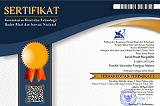Optimalisasi Penggunaan Benih Mandiri untuk Meminimalisir Biaya dan Ketergantungan pada Kegiatan Pembesaran Ikan Nila
Abstract
The village of Tulorantea is one of the villages where the community is engaged in tilapia fish farming. The tilapia fingerlings used are generally imported from other regions at a relatively high cost (> Rp. 1000/individual with a size of 3-5 cm), and they are often ordered in large quantities. This situation poses a threat to the sustainability of small-scale tilapia farming. In addition, the profits obtained by fish farmers at the end of the cultivation period are relatively low. One of the efforts to address this issue is the use of self-produced fingerlings. This can be achieved successfully if the breeding process of tilapia is well understood by the farmers. Therefore, the purpose of this community service is to provide farmers with an understanding of the proper methods for tilapia breeding to produce self-produced fingerlings and strategies for marketing quality fishery products. This activity is conducted in the form of counseling, with participants from the village government and fish farmers. Two weeks after the counseling, 100 potential breeders (25 males and 75 females) and net cages for acclimatizing the potential breeders are handed over to the fish farmers. The results of the activity show that the fish farmers are very enthusiastic about participating in the program and becoming involved in tilapia breeding to produce self-produced fingerlings to support their farming activities. In conclusion, problem-based counseling activities aimed at addressing the challenges faced by fish farmers have increased the enthusiasm of fish farmers in their efforts to achieve optimal production.
Keywords
Full Text:
PDF (Bahasa Indonesia)References
Agung, T. (2019). Teknik Pemijahan Ikan Nila (Oreochromis niloticus) di UPTD Balai Benih Ikan Mojoranu, Desa Mojoranu, Kecamatan Dander, Kabupaten Bojonegoro UNIVERSITAS AIRLANGGA].
Arfiati, D., Farkha, K., & Anugerah, D. P. (2022). Ikan Nila (Oreochromis niloticus). Media Nusa Creative (MNC Publishing).
Badan Standarisasi Nasional, S. (2009). Produksi Ikan nila Hitam (Oreochromis niloticus Bleeker) Kelas Induk Pokok. In.
Chakraborty, S. B., Mazumdar, D., Chatterji, U., & Banerjee, S. (2011). Growth of Mixed-Sex and Monosex Nile Tilapia in Different Culture Systems. Turkish Journal of Fisheries and Aquatic Sciences, 11(1), 131-138.
Fradina, I. T., & Latuconsina, H. (2022). Manajemen Pemberian Pakan pada Induk dan Benih Ikan Nila (Oreochromis niloticus) di Instalasi Perikanan Budidaya, Kepanjen-Kabupaten Malang. JUSTE (Journal of Science and Technology), 3(1), 39-45.
Heriyati, E. (2013). Sex reversal ikan nila menggunakan tiga jenis madu. Jurnal Pertanian Terpadu, 1(2), 52-60.
Malik, T., Syaifudin, M., & Amin, M. (2019). Maskulinisasi ikan guppy (Poecilia reticulata) melalui penggunaan air kelapa (Cocos nucifera) dengan konsentrasi berbeda. Jurnal Akuakultur Rawa Indonesia, 7(1), 13-24.
Safir, M. (2018). Respons Fisiologis dan Biokimia Ikan Nila Hasil Sex Reversal, Diberi Pakan Kadar Protein Berbeda dan Diperkaya dengan Hormon Pertumbuhan IPB (Bogor Agricultural University)]. IPB.
Safir, M., Alimuddin, Setiawati, M., Junior, M. Z., & Suprayudi, M. A. (2017). Growth Performance of Nile tilapia Immersed in 17α-methyltestosterone and rElGH, and Fed a Diet Enriched with rElGH. Omni-Akuatika, 13(2).
Safir, M., Ghandi, I., & Serdiati, N. (2023). Persentase Jantan Ikan Nila (Oreochromis niloticus) Hasil Perendaman Dengan Ekstrak Daun Senggani (Melastoma candidum) Dosis Berbeda. Ruaya; Jurnal Penelitian dan Kajian Ilmu Perikanan dan Kelautan.
Safir, M., Rukka, A. H., Mangitung, S. F., & Sambaeni, D. (2020). Pengaruh Perendaman Hormon 17α-Methyltestosteron dan Suhu yang Berbeda Terhadap Persentase Kelamin Jantan dan Performa Pertumbuhan Ikan Banggai Cardinal (Pterapogon kauderni). Octopus: Jurnal Ilmu Perikanan, 9(2), 059-065.
Sudrajat, M. A., Astutik, I., & Arfah, H. (2007). Sex reversal of red tilapia (Oreochromis sp.) by larval immersion using aromatase inhibitor. Jurnal Akuakultur Indonesia, 6(1), 103-108.
DOI: https://doi.org/10.21107/pangabdhi.v9i2.22474
Refbacks
- There are currently no refbacks.
Copyright (c) 2023 Novalina Serdiati, Nasmia Nasmia, Made Antara, Akbar Marzuki Tahya, Muhammad Safir

This work is licensed under a Creative Commons Attribution-ShareAlike 4.0 International License.
Jurnal Ilmiah Pangabdhi by Universitas Trunojoyo Madura is licensed under a Creative Commons Attribution-ShareAlike 4.0 International License.













